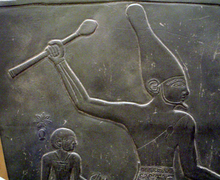Narmer: Difference between revisions
Phantomsteve (talk | contribs) m Reverted edits by 204.185.4.253 to last revision by ClueBot (HG) |
No edit summary |
||
| Line 7: | Line 7: | ||
Horus=''Narmer''| |
Horus=''Narmer''| |
||
Predecessor= [[King Scorpion|Scorpion]]? or [[Ka (Pharaoh)|Ka]]| |
Predecessor= [[King Scorpion|Scorpion]]? or [[Ka (Pharaoh)|Ka]]| |
||
Successor [[Menes]]? or [[Hor-Aha]]?| |
Successor= [[Menes]]? or [[Hor-Aha]]?| |
||
Spouse= [[Neithhotep]] | |
Spouse= [[Neithhotep]] | |
||
Issues= [[Menes]]? [[Hor-Aha]]? | |
Issues= [[Menes]]? [[Hor-Aha]]? | |
||
Revision as of 17:17, 24 September 2009
This article may be confusing or unclear to readers. (September 2009) |
| Narmer | ||||||||||||||||||
|---|---|---|---|---|---|---|---|---|---|---|---|---|---|---|---|---|---|---|
 Narmer in the traditional pose of smiting the enemies of Egypt from the Narmer Palette. | ||||||||||||||||||
| Pharaoh | ||||||||||||||||||
| Predecessor | Scorpion? or Ka | |||||||||||||||||
| Successor | Menes? or Hor-Aha? | |||||||||||||||||
| ||||||||||||||||||
| Consort | Neithhotep | |||||||||||||||||
| Burial | Tomb B17/B18, Umm el-Qa'ab, Abydos | |||||||||||||||||
| Dynasty | 1st Dynasty | |||||||||||||||||
Narmer was an Egyptian Pharaoh who ruled in the 31st century BC. Thought to be the successor to the predynastic Kings Scorpion or "Selk" and/or Ka, he is considered by some to be the unifier of Egypt and founder of the First dynasty, and therefore the first king of all Egypt. There is a growing consensus that Scorpion and Narmer are identical, but no identification with any early king can yet be definitively proven.
Reign

The famous Narmer Palette, discovered in 1898 in Hierakonpolis, shows Narmer displaying the insignia of both Upper and Lower Egypt, giving rise to the theory that he unified the two kingdoms in c. 3100 BC.[1][2] Traditionally, Menes is credited with that unification, and he is listed as being the first king in Manetho's list of kings, so this find has caused some controversy.
Some Egyptologists hold that Menes and Narmer are the same person; some hold that Menes is the same person as Hor-Aha and that he inherited an already-unified Egypt from Narmer;[3] others hold that Narmer began the process of unification but either did not succeed or succeeded only partially, leaving it to Menes to complete. Arguments have been made that Narmer is Menes because of his appearance on several ostraca in conjunction with the gameboard hieroglyph, Mn, which appears to be a contemporary record to the otherwise mythical king.[4] At the site of Nahal Tillah (see below) a pottery shard was found with the serekh of king Narmer, showing that the Egyptian kings had five royal names, one of which also included the signs for mn (Menes) without further title but adjacent to the Horus name of Narmer. This would lead to the conclusion that Menes' royal name included Narmer. However, there are also inconsistencies within every ostracon which mentions Menes, precluding any definitive proof to his identity.[5]
Another equally plausible theory is that Narmer was an immediate successor to the king who did manage to unify Egypt (perhaps the King Scorpion whose name was found on a macehead also discovered in Hierakonpolis), and adopted symbols of unification that had already been in use for perhaps a generation. The king lists recently found in Den's and Qa'a's tombs both list Narmer as the founder of their dynasty who was followed by Hor-Aha (Menes was not mentioned).
His wife is thought to have been Neithhotep A (=Neith is satisfied), a princess of northern Egypt. Inscriptions bearing her name were found in tombs belonging to Narmer's immediate successors Hor-Aha and Djer, implying that she was the mother of Hor-Aha.
Name
Narmer's name is represented phonetically by the hieroglyphic sign for a catfish (n'r) and that of a chisel (mr). Modern variants of his name include "Hor Narmeru" or "Hor Merinar" (Horus, beloved of Nar, hence perhaps Meni (Mn)?), but scholarly convention favors "Narmer".[6]
Tomb and artifacts
His tomb is composed of two joined chambers (B17 and B18) found in the Umm el-Qa'ab region of Abydos. It is located near Ka's tomb who ruled Thinis just before him.
During the summer of 1994, excavators from the Nahal Tillah expedition in southern Israel discovered an incised ceramic shard with the serekh sign of Narmer, the same individual whose ceremonial slate palette was found by James E. Quibell in Upper Egypt. The inscription was found on a large circular platform, possibly the foundations of a storage silo on the Halif Terrace. Dated to ca. 3000 BC, mineralogical studies of the shard conclude that it is a fragment of a wine jar which was imported from the Nile valley to Israel some 5000 years ago.
Narmer had Egyptian pottery produced in southern Canaan — with his name stamped on vessels — and then exported back to Egypt.[7] Production sites included Arad, En Besor, Rafiah, and Tel Erani.[7]
Gallery of images
-
Alabaster statue of a baboon divinity with the name of the pharaoh Narmer inscribed on its base, on display at the Ägyptisches Museum Berlin.
-
A mud jar sealing indicating that the contents came from the estate of the pharaoh Narmer. Originally from Tarkhan, now on display at the Metropolitan Museum of Art, New York City.
-
Pottery shard inscribed with the serekh and name of the pharaoh Narmer, on display at the Museum of Fine Arts, Boston.
See also
References
- Possibly Copied: http://www.crystalinks.com/narmer.html
- Dodson, Aidan. Hilton, Dyan. The Complete Royal Families of Ancient Egypt, Thames & Hudson 2004
- Gardiner, Alan. Egypt of the Pharaohs., Oxford University Press, 1961
- Kinnaer, Jacques. What is Really Known About the Narmer Palette?, KMT: A Modern Journal of Ancient Egypt, Spring 2004.
- Shaw, Ian. The Oxford History of Ancient Egypt., Oxford University Press, 2000.





